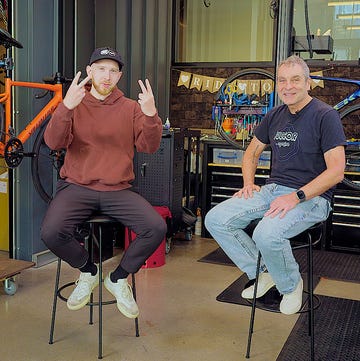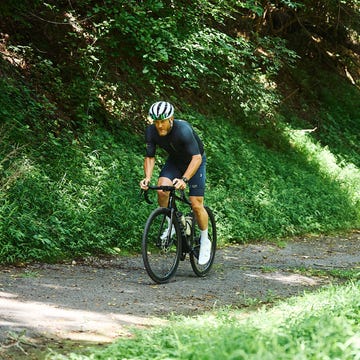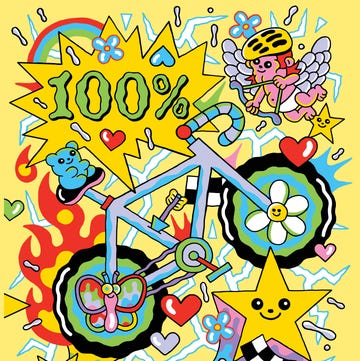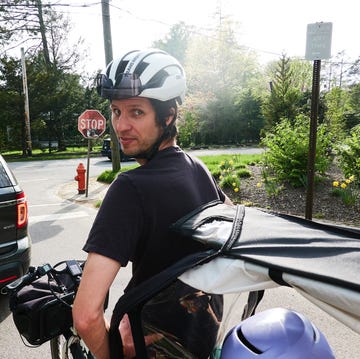About three months ago, I was walking upstairs to my apartment after a ride on a Friday afternoon when I felt something strange happen to my right knee. It wasn’t necessarily pain, and my knee didn’t collapse from underneath me. But it felt ‘different’. I immediately thought, “That didn’t seem right.” Until then, I had not experienced anything similar in my decades of cycling.
My knee remained sore throughout that weekend and into the following week. I iced it with a bag of frozen peas and took ibuprofen. I didn’t ride hard for another week until my knee felt better. Then, ten days later, after another particularly grinding ride with some hills, the soreness returned. So, I repeated the same ice, rest, and ibuprofen routine until my knee felt good again.
When the soreness reemerged a couple of weeks later, I asked my colleague and certified personal trainer, Natascha Grief, for advice. Her input and suggestions not only helped resolve my sore knee, but I also gained confidence and strength on the rides. And I learned a lot more about how to avoid re-injury.
Knee Pain Basics
Like most joints on your body, your knees are complex structures. The knee joints’ bones, ligaments, cartilage, and muscles can be damaged through riding or other life activities. And you can experience an injury directly (such as a crash or twisting your knee) or indirectly through overuse, muscle imbalance, poor fit, or other systemic issues.
These indirect injuries are common for cyclists and, as I learned from Natascha, were at the root of my soreness. Read our story “How to Address Common Causes of Knee Pain While Cycling” for some basics on knee pain and possible causes on the bike. Consult a trained medical professional if your knee pain is serious, or adjustments to your riding position or exercises do not resolve the aches and soreness.
Unfortunately, like many cyclists, I do not spend enough time working on other areas of overall fitness; I simply ride my bike a lot. Honestly, I traditionally avoid areas of off-bike fitness such as stretching, core stability, strength training, and proper recovery (I do, however, try my best to warm up before rides). This lack of balance in my training has been detrimental and ultimately contributed to my knee issues.
The Foam Roller Exercises
After discussing my sore knee, how I experienced it, and the steps I’ve taken to remedy it, Natascha assessed my off-bike posture and strength. Since I had a professional bike fit about a year ago (for a custom bike test), and I apply those measurements to other road and gravel bikes I test, we did not alter my bike fit when troubleshooting my knee pain.
Based on the initial assessment, Natascha noted three areas of muscle imbalance and instability that, combined with lingering mobility issues from numerous previous injuries, likely caused my soreness. She identified tight quads, tight calves, and poor core stability as areas for initial focus.
Natascha prescribed three simple foam rolling exercises to help address my imbalances and instability. I performed these exercises 15 to 30 minutes daily for four weeks and had good results. She recommended that I do these using a long foam roller. I own an extra-firm density smooth roller, but use the density and surface that best suits your body.
Quads
We started by foam rolling the muscle above the knee joints (on both legs) to work on my tight quadriceps. Do not foam roll on the joint, as this can cause damage. I focused only on roughly the first third of the area above my knees for the first week. Then, for the weeks that followed, I rolled the full length of my quad from above the knee to my hip.
Front of Calves
The next exercise was foam rolling my calves, particularly focusing on the front/outside shin area. Do not foam roll directly on your shin to avoid injury. I often suffer from shin splints (especially during cyclocross season when running with the bike comes into play) and soreness in my calves; I found this exercise painful at times (but not excruciating). I started by gently rolling the anterior muscle and then eased into adding pressure to work through tender areas and trigger points.
Core Stability
In addition to foam rolling my quads and calves, Natascha recommended specific exercises using the foam roller as support. When lying lengthwise on a full-length foam roller, I addressed core stability and mobility with stretching and breathing exercises. Training my core muscles allows me to use more of my upper body when riding, reducing poor posture that can lead to other injuries, like my sore knee.
First, she taught me to engage and train my core muscles while focusing on diaphragmatic breathing. The objective here was to concentrate on stability and balance on the roller. Getting my pelvis into a neutral position is a tip Natascha gave me to improve my breathing form. This is important for this exercise because you want your lower back to make gentle contact with the foam roller instead of arching.
I did this by placing my thumbs on my last ribs and index or middle finger on the iliac crest (the bony part of your hip), and learning how to properly engage my core muscles that bring my pelvis in a neutral posture by trying to shorten the distance between my thumb and index finger without sucking in my stomach. Then I learned how to use my diaphragm while breathing by placing my hands on both sides of my rib cage, then focusing on pushing my ribs as far apart as possible with each inhale and relaxing with each exhale. It was easier to tune into this by focusing on pressing my hands as far out to the side as possible with my ribs.
Next, we addressed my upper body strength and mobility since I have tight pectoralis muscles from riding dropbar bikes. Helping increase upper body mobility allows riders to better support and distribute their weight on the bike. We began with my arms slightly outstretched with palms facing down. As I rotated my arms like a snow angel, I switched to have my palms facing up. While doing this exercise, I braced my core muscles and focused on not arching my back.
Results and Postscript
I had noticeable results after performing this foam roller routine for about 20 to 30 minutes daily over two weeks. While the soreness was not completely gone, it didn’t hurt or feel unstable while riding or off the bike.
My knee pain and the issue, seemingly, were resolved after four weeks of daily foam roller workouts (I only missed one day in four weeks). Additionally, my posture on the bike improved; I sat more upright and could engage my core muscles during seated climbing and hard efforts. I also had more confidence and felt stronger when sprinting or climbing out of the saddle.
However, these issues can quickly return without regular maintenance. And I discovered this the hard way during a week-long trip to California to visit bike brands and attend the Sea Otter Classic. I did not bring my foam roller on the trip and was lax about stretching before rides. My right knee was sore again (though not as bad as before) after a cross-country flight, daily rides, and a lot of walking in inappropriate footwear.
So, now it’s back to the foam roller routine. This time I need to make it stick!
As Deputy Editor, Tara Seplavy leads Bicycling’s product test team; after having previously led product development and sourcing for multiple bike brands, run World Championship winning mountain bike teams, wrenched at renowned bicycle shops in Brooklyn, raced everything from criteriums to downhill, and ridden bikes on six different continents (landing herself in hospital emergency rooms in four countries and counting). Based in Easton, Pennsylvania, Tara spends tons of time on the road and trail testing products. A familiar face at cyclocross races, crits, and bike parks in the Mid Atlantic and New England, on weekends she can often be found racing for the New York City-based CRCA/KruisCX team. When not riding a bike, or talking about them, Tara listens to a lot of ska, punk, and emo music, and consumes too much social media.

Natascha Grief is Bicycling’s Health & Fitness Editor. She started in the cycling industry as a bike mechanic a couple of decades ago, earning a couple pro-mechanic certifications and her USA Cycling Race Mechanic license. She went on to apprentice for framebuilder Brent Steelman in her hometown of Redwood City, California before spending several years working for both large and not-so-large cycling brands. She then switched gears and industries to earn multiple personal training certifications while honing her skills as a trainer and coach, specializing in functional training, corrective exercise, and body positive personal training. She began contributing regularly to Runner’s World and Bicycling as a freelance writer in 2020, and joined the editorial staff of Bicycling in 2022.



















